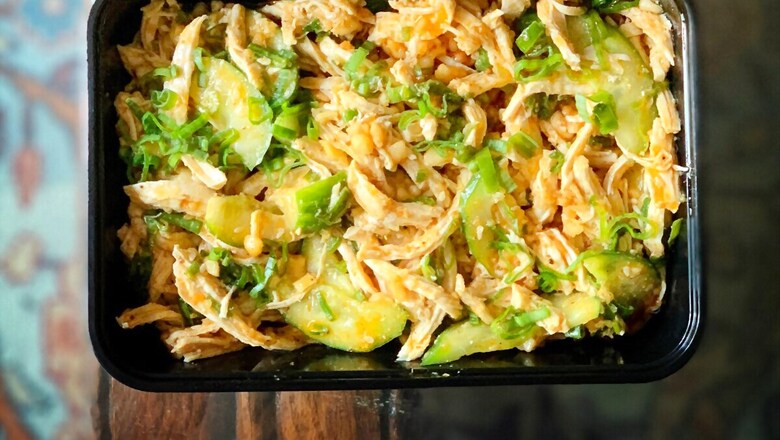
views
Now I know Bang Bang Chicken sounds like something created on a Mumbai street or in a ‘Chindian’ Restaurant, but it is in fact a traditional Sichuan street food dish from China. It’s a burst of flavours and textures and is quite simply shredded chicken, julienned cucumber, and a spicy sauce. It’s full of robust character that comes from the brothy meatiness of chicken fat, the nuttiness of sesame oil, the sharpness of chilli oil, the wallop of black vinegar, the bracing heat of ginger and the fierce fire of Sichuan pepper.
Understanding Sichuan Cuisine
But wait, to appreciate Bang Bang Chicken better, we need to understand the basic carriage of Sichuan food. Growing up in India, misspelling it as Szechuan was common. Spicy Chinese food available on the streets and in restaurants was Szechuan Chinese. In India, what Szechuan cooking meant was the over-exuberant usage of chilly sauce, green chillies, garlic, soy sauce, vinegar and ajinomoto. Punjabi-owned Chinese restaurants were audaciously named Szechuan Corner, Szechuan Garden, Spicy Szechuan, or just The Szechuan.
But there’s more to Sichuan cooking than scalded taste buds and a cauterized mouth. The cuisine has incredible depth and complexity. Sichuan food is a medley of textures and flavours; spicy, salty, sour, sweet, bitter, smoky, and even flowery, because of the original Sichuan peppercorn. The food goes beyond just inflaming your tongue and caresses all the senses—your mouth, nose, and the stomach at the same time.
ALSO READ | What The Fork: Who Invented Chicken Manchurian, Indians or Chinese? Kunal Vijayakar Has the Answer
The cuisine gets its name from Sì Chuānlù which literally translates as, ‘four plain circuits’, a landlocked part of Southwest China where its humid climate encourages the growth of the Sichuan pepper, a unique spice that is less pepper-like and more citrus-like. A spice that induces a tingling numbness in the mouth. Sichuan Cuisine can easily be considered not only China’s favourite cuisine, but also the world’s most favoured Chinese food. Apart from the pepper, the other spices used in Sichuan cooking are ‘The Five Fragrances’—fennel, pepper, aniseed, cinnamon, and clove.
What is Bang Bang?
Coming back to Bang Bang Chicken, I first tasted it at a P.F. Chang’s outlet wandering around at Los Angeles Airport. Intrigued by its name I ordered it. It turned out to be fried chicken pieces in a really tasty sweet chilly mayo sauce. I devoured the crispy morsels, quite enjoying myself and at the same time imagining that this had to be some American creation, and that anything remotely Chinese couldn’t possibly be called Bang Bang.
I was wrong. The name “Bang Bang” describes the action of beating poached chicken with sticks or batons to shred the meat. It was only later in London’s Chinatown that I got to sample a slightly more faithful version. Unlike the P.F. Chang’s version, this chicken was shredded. These shredded pieces of chicken are then mixed with sliced or julienned cucumber and a sauce made by blending garlic, ginger, peanut butter, soy sauce, toasted sesame oil, rice vinegar, sugar and crushed Sichuan peppers. It’s light, refreshing, nutty and quite cheery.
In fact at The Ivy, a traditional British Covent Garden, London restaurant since 1917, Bang Bang Chicken remains an all-time favourite on the menu. Their version is a salad of shredded carrot, mooli, mangetout, spring onions and bean sprouts, tossed in olive oil and lime juice. Shredded chicken which is poached with the lime leaves, ginger slices, lemongrass, coconut cream, soy sauce and red chilli is laid on top of the dressed salad and drizzled with a sauce made with peanut butter and hot chilli sauce, and sesame oil. The dish is then garnished with crushed roasted peanuts.
The two versions I like in Mumbai are made by Seefah at Bandra and Ginkgo Pan Asian Kitchen, a newly opened takeaway. Both their versions differ slightly from each other and from the authentic Bang Bang. Seefah makes theirs like a salad and is best eaten cold, while Ginkgo’s is a dark potent and hardy spicy interpretation. But they are both a crunchy, sweet, spicy, refreshing and nutty explosion of flavours. So, if you’re in the mood for some banging good chicken, some Bang Bang will do you a whole lot of good.
Read all the Latest News, Breaking News and Coronavirus News here.
















Comments
0 comment